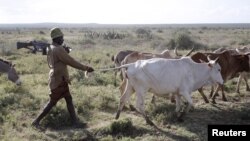Violence surged in rural central Kenya earlier this year as armed northern herders brought thousands of cattle, sheep and goats onto private property, prompting clashes that took the lives of humans and wildlife.
As drought raged on, it did not help that some politicians encouraged constituents to graze their livestock wherever they could find grass and water.
Peter Hetz, executive director of the Laikipia Wildlife Forum, says that although the recent elections and change in government were peaceful, there are still unresolved issues.
“People are feeling optimistic and empowered by the power of the vote and the ability to vote out some of the people who were implied in the early politicization of this county and the maneuverings of armed people, and livestock. And I think people are generally feeling good,” said Hetz. “The fact remains that there are still people who have guns and there are still livestock that don’t belong here, roaming the territory and the government must still resolve to do something about that.”
According to Kenya’s Ministry of Interior spokesman, Mwenda Njoka, security operations in the central parts of the country are still ongoing.
“I could give assurance to both the locals and the foreigners who are in that area that at least security has returned to normal, has significantly normalized,” said Njoka.
Josh Perrett, manager of Laikipia’s Mugie Ranch, agrees that things have improved since earlier this year: the grass has returned, the wildlife look better, and poaching has dropped "significantly."
Illegal grazing remains
But Perrett says the illegal grazing continues, citing several occasions since the end of July when his team has caught herds of roughly 400 cattle at a time on the property.
“Every day we have issues with cows coming in from somewhere. It’s just not to the scale or to the aggression that it was in January,” said Perrett.
The relative gains experienced in central Kenya have not reached the northern semi-arid rangelands, home of many of the pastoralists, according to Frank Pope, CEO of Save the Elephants.
He says that after many decades of sustained overgrazing and rising human populations, the top soil has now disappeared from many of the areas. And as a result, there is nowhere for the large numbers of goats and cattle to graze.
“And everyone is chasing the last grass. There’s been no good rain in the north. There have been some patches of rain, but really, there’s no let up for the situation in the north. And we’ll wait to see what the new government decides to do and whether they decide they can grasp this nettle of how to control grazing amongst the pastoralists. But if they don’t, I think the north will continue its march towards full desert conditions,” said Pope.
Experts have encouraged the government to implement long-term rangeland management practices in the north, and to explore options of tagging livestock, in order to keep track of who owns which animals.












